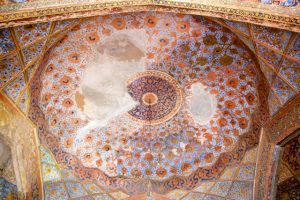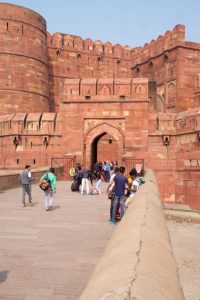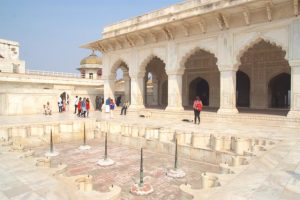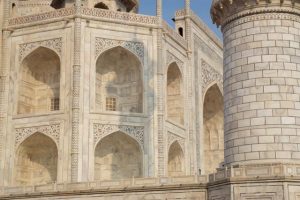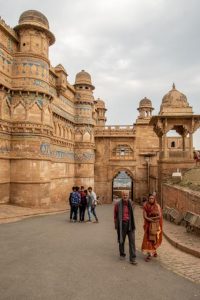Before the alarm went off I was fully awake so I could shower and finish packing at ease. Breakfast was simple, an omelette and black tea, and not much later my rickshaw driver arrived to bring me to the airport. Checking in was a piece of cake, especially for Air India standards. I passed through all security checks, checkin and more security checks without the usual hassle and not much later I sat in the departure hall and relaxed before my five hour journey to Delhi.
Once we arrived I grabbed my luggage and took a taxi to my hotel. My driver wanted to drop me at a very nice area with boutique shops but I insisted on being dropped at the hotel as was agreed upon…
Villa 33 was a lovely place. The interior was very old fashioned British and the whole felt more like a welcoming family home than a hotel. I was welcomed by the friendly owner, who’s son is studying in Amsterdam and brought to my room. There I enjoyed an afternoon nap to recover from the journey.
Later that evening I went to the SDA market, a place full of restaurants and even a beer café, there I enjoyed a large draught Kingfisher before I looked for a nice restaurant to eat.
That night I did not sleep very well and as a result of that was quite dizzy in the morning. I opted for a quiet day, made a short stroll through the neighbourhood and read some more in my room. The good thing is that I had visited Delhi three times before so I did not have the feeling I was missing out on something…
Next day started of as another relaxing one. After breakfast I returned to my room, switched the heating on (had not experienced Delhi to be this chilly) and updated my journal. After that I read a bit. I had already decided to leave Delhi as it was. At 2pm I had an appointment with my good friend Rohnit, who was such a wonderful host for me last year whilst visiting Kolkata. He was in Delhi and we could not miss out the opportunity to meet so I invited him for a beer and lunch at the SDA market. We met at the beer café And I was introduced to a good friend of his, Bedajit, before we went inside for a drink and a small bite to eat.
It was lovely to see Rohnit again, we caught up on memories of last year, his new enterprise in New Delhi and his guesthouse in Sikkim. Mot most of all there was laughter, much laughter. Time was flying by and just after five we said goodbye and I returned to Villa 33 for a short nap.
And just before seven it was time for the second appointment of the day. Neha, my friend from the cooking classes, and her husband picked me up and we drove to a nice Punjabi Grill restaurant. It took us a while to order as we had so much to discuss. I only saw them last year for another cooking class and the celebration of Holi and we caught up just as we had seen each other last week. A fantastic evening indeed, the perfect way to finish of my stay in Delhi.
Travelling is a wonderful thing, not only seeing new places and discovering new cultures but most importantly meeting people and making friends. Today I felt a bit like Delhi was my home having such wonderful people around.
Next day was an early rise in order to catch a train to Agra. My taxi showed up at 7am precisely as agreed and brought me to Nizamuddin railwaystation where I boarded the Gatimaan express to Agra. This is, until now the fastest train in India, although a faster one is in the making. My seat in executive class was extremely comfortable which made the just under two hour journey a pleasure. The speed of over 160 km an hour was something I had to get used to, this was definitely something I had not experienced in India before…
In Agra I took a rickshaw to my homestay which turned out to be very pleasant indeed. I had to eat a bit before my room was ready. It it was worth the wait. A spacious and lovingly decorated room with warm colours, although decorated typically in an Indian style the colour scheme reminded me of my guesthouse in Quito, Ecuador. Bright and vivid…
I walked towards the main road leading towards the Taj Mahal and found a nice rooftop restaurant with a stunning view over the Taj, this made lunch even taste better.
Next I arranged a Rickshaw and instead of rushing to Agra’s main attraction I asked my driver to bring me to Itimad-Ud-Daulah, which is affectionately known as the jewel box or baby Taj. It was completed in 1628 and by the time I saw it for the first time I remembered I had seen it before in 2009 during my first visit to India with Paul. Although much smaller than it’s famous brother I loved the mausoleum and it’s surrounding garden. It was built for Asmat Begam, the wife of Mirza Ghias Beg, Prime minister of the Mughal emperor Jahangi.
Next stop was Mehrab Bagh, the last one of 11 Maghul gardens built around Agra. It was located besides the Yamuna river and perfectly positioned north of the Taj Mahal. Originally this was the spot where the black Taj was supposed to be built but this never happened. The garden itself was not very interesting to be polite but of course all attention was drawn by the Taj Mahal across the Yamuna River. As the water levels in the river were low at this time of year I could not see the famous reflections but I was pleased as it was.
I wanted to return to the hotel but my driver had other ideas. There were after all so many interesting shops and factories to be seen and I had already more or less expected this. Regardless of the fact whether you buy or not the rickshaw driver gets a small commission for every guest he brings to a place. When I confronted my driver I was aware of this he had a big smile on my face so I agreed to limit his list of ‘interesting places’ to two before returning to the hotel. In both cases I patiently admired the skills, watched the goods and left empty handed whilst the salesmen tried to hide their disappointment on a missed chance for a sale.
In the hotel I relaxed at the roof terrace enjoying a old monk rum with coke and updated my journal with the Taj at the horizon. Dinner was served and I had a nice conversation with some other guests before I called it a day.
That night I slept very well and did not wake up until 7 o’clock. Looking outside I noticed the haze in the air and was glad I had not woken up early for sunrise. After breakfast the haze had not yet been burned away by the sun so I changed my plan for the day and altered the sequence of visits, knowing it would be more crowded later on the day.
First I asked my driver to bring me to Sikandra, about 10km northwest of the Agra Fort. I wanted to visit Akbar’s Mausoleum, an outstanding sandstone and marble tomb twhich commemorates the greatest of the Moghul emperors. I loved strolling through the huge courtyard end enjoyed the stunningly decorated interior, it certainly had been worth the short rickshaw ride. On the way back we passed another tomb which seemed to have been a bit neglected, an easy thing to do with such great historic sites in the area. we made a short stop and although it was not clear to me when it was built or who was buried here I did enjoy it.
We continued our drive back to Agra Fort but first I wanted to stop at the Gurudwara Gura Ka Tal tempel. Since my visit to Punjab the year before I had a soft spot for Sikh temples and this one proved to be another fine one. I love the tranquil atmosphere in Sikh temples, everyone is welcome for something to eat or pray if they want to and somehow the Sikhs seem to be extremely friendly and talkative. Over here was no exception.
It did not take long before we arrived at another highlight in Agra, the Agra Fort. As expected it was extremely rowdy but I did take my time to stroll through the parts of the fort that are open to the public of what must be one of India’s most impressive ancient forts. Like in 2009 I was blown away.
From the fort it was only a short ride to the main attraction of Agra, the Taj Mahal. My driver dropped me off afer which I strolled at ease towards the west gate of the Taj, got my entrance ticket and mandatory plastic covers for my shoes. After some heavy security checks I continued to the main entrance building and there she was…
Widely considered as one of the most beautiful buildings in the world, the Taj Mahal is the prime example of Islamic art in India. Called the “monumental ode to love”, it was built by the Mughal Emperor Shah Jahan as a memorial for his third ( and favourite) wife, Mumtaz Mahal. Entirely made of white marble, the mausoleum has intricate carvings on all its walls and attracts large groups of visitors year after year. Efforts to conserve the fragile white marble have gone as far as banning all heavy industry in a range of 100 km.
It was extremely crowded but I was happy to have postponed my visit till mid afternoon so all haze was gone and the skies were clear. The sun was also in a much lower position which set the Taj in a stunning soft light, making it even more beautiful than it already was.
The mosque at one side of the Taj was not that interesting so I proceeded to the Taj itself whilst the shivers ran down my spine. It was rather emotional for me to be back at this building 10 years since I first saw it. I was happy that this time there was water in all channels which caused great reflections of this stunning monument of love.
The marble and it’s inlays of precious and semi-precious stones were fantastic. then there were the carvings to be admired as well. So much attention for detail, so much love put into this staggering ode to love.
Unlike 10 years ago an additional ticket was required to enter the mausoleum, no photography was allowed inside and you had to be constantly on the move so you could only get a short glimpse of the central burial chamber and the graves. Still it felt good to see it once again. Once outside I strolled around, always on the quest for the perfect picture.
After almost 2 1/2 hour I returned to the exit and enjoyed a beer in one of the many restaurants. Back at coral court homestay I met a Swiss/Italian couple and we ended up with a vivid conversation and dinner together.
Another day had come to an end, a busy one but I loved every single moment of it. I slept well that night and during my dreams revived experiences of that wonderful day in Agra.
A bit of a sleep in (7:30 is definitely a sleep in for Indian standards), breakfast and a slow start of the day… Then I ordered a taxi to Fatahpur Sikri, another stunning place I visited 10 years ago.
Driving through Agra made me feel a bit sad as I realised how dirty it was. Plastic all over and the cows were scraping it for reminders of eatable things. It was a sad view indeed and it seemed Delhi appeared to be so much cleaner.
As soon as we left the city we took a toll road towards Fatehpur Sikri and we could really speed up. Within an hour we had reached my destination and I grabbed a CGN bus for the last kilometre and a half to the ruins.
Fatehpur Sikri, a magnificent fortified ancient city, 40km west of Agra, was the short-lived capital of the Mughal empire between 1572 and 1585, during the reign of Emperor Akbar. Earlier, Akbar had visited the village of Sikri to con- sult the Sufi saint Shaikh Salim Chishti, who predicted the birth of an heir to the Mughal throne. When the prophecy came true, Akbar built his new capital here, including a stunning mosque, still in use today, and three palaces, one for each of his favourite wives – one a Hindu, one a Muslim and one a Christian (though Hindu villagers in Sikri dispute these claims). The city was an Indo-Islamic masterpiece, but erected in an area that supposedly suffered from water shortages and so was abandoned shortly after Akbar’s death.
Like 10 years ago I was impressed by them. I strolled at ask through most of the abandoned buildings and admired the architecture. All original decorations were no longer visible of course but I could imagine the wealth that once was available for those lucky few.
Next to the the palace ruins a large, still functioning mosque was built, Namid Masjid. Around a massive square several prating areas were located and one could not miss the white marble tomb of Sufi saint Shaikh Salim Chishti Prominently located opposite Buland Darwaza, the victory gate.
I was allowed to enter the tomb, though had to lower my shorts a bit so my knees were covered and was given a green plastic cap to cover my head. I followed the pilgrims clockwise around the grave and once completed was treated with bashes of a broomstick on my head. As everyone received this “blessing” I underwent it without any further comments.
Under the roofs of the large arches bees had built large beehives which were being sprayed and destroyed today. This resulted in an unprecedented amount of dead and half dead bees on the floor, something not very comforting whilst walking on bare feet.
As there were so many dead bees on the floor under the victory gate I did not feel like crossing that barefoot and returned to the entrance where I entered the complex and approached the main gate from the outside. Over there I saw even more dying bees so I was glad I made the right decision not to walk through that bee graveyard.
The return journey to Agra was uneventful and once back at my hotel I grabbed a beer and enjoyed the late afternoon sun at the rooftop terrace. I met a friendly German couple and we spent the rest of the afternoon chatting and enjoyed dinner together. It did not become a late night though.
Next day was a travel day again. I packed my luggage, showered and enjoyed my last breakfast at coral court and grappled a rickshaw to Agra Cannt Railway Station. I was in perfect time so had some time to relax before the Gatimaan Express arrived at platform 1. It was easy to find my coach and assigned seat and not much later we were on the way to Gwallior.
It did take just over an hour at Gwallior and there I took a taxi to my hotel. After my perfect place in Agra it was a bit of a disappointment (huge understatement), a rather shabby place with no facilities at all and where clean was written with a very small c… Oh well, it was only for two nights.
My driver had made me an offer to show me around which I accepted and our first stop was the Gwalior fort. The fort has existed at least since the 10th century, and the inscriptions and monuments found within what is now the fort campus indicate that it may have existed as early as the beginning of the 6th century. The fort is built on an outcrop of Vindhyan sandstone on a solitary rocky hill called Gopachal. It overlooks the town of Gwalior and in total it stretches an amazing length of 2,4 kilometres, although only 700 meters wide at its widest place.
The present-day fort consists of a defensive structure and two main palaces, Gujari Mahal and Man Mandir, built by Man Singh Tomar (reigned 1486-1516 CE). The Gujari Mahal palace was built for Queen Mrignayani. It is now an archaeological museum. The major temple was still accessible and was like a labyrinth of narrow hallways and stairs leading to some courtyards and rooms. I really do not know whether I have seen everything in this maze as somehow I seemed to come back to the same places all the time but I enjoyed it a lot and it was a fun experience.
Next stop was the Sas Buhu temple, located on top of a hill, some of the inscriptions at this magnificent place were over 1500 years old. The views over Gwalior from here were simply breathtaking.
There was another old temple within the fort, the Teli Ka temple, beautifully decorated and stunning carvings from the outside although the central prayer room was simply bare. I assume it must have been stripped from all decorations over the years, such a shame.
A new temple at the fort’s premises was the Gurudwara Bandi Chor, a Sikh temple which is associated with the imprisonment of Guru Har Gobind Sahib in Gwalior Fort and his celebrated release in which he managed to win the freedom of 52 Rajas (Kings) who had long suffered imprisonment in Fort.
Like all Sikh temples there was an enormous hospitality, I was not only invited to visit the holy shrine but was also offered free food. This is an integral part of Sikh community services and they do not discriminate against religion or race, everybody is more than welcome. As I just had lunch I skipped the meal.
Once we left the fort through the western Urwai gate there was still one place to be visited that blew my mind. My driver dropped me at the side of the road after which I saw the first magnificent Jain sculptures cut out in rocks beside the road.
A bit further down there was an even bigger site and as it was further away from the road I could enjoy this splendid work even more.
The Jain Temple Caves were built in 7th to 15th century. On the southern side there are 21 temples cut into the rock with intricately carved of the Tirthankaras. The tallest Idol is the image of Rishabhanatha or Adinatha, the 1st Tirthankara, which is almost 18 meter high. As I had not expected anything like this I was completely overwhelmed. Once again it proves the diversity of India and why I love it so much. Each day is full of surprises…
Back at the hotel there was not much to do so I remained at my room and updated my journal. With no restaurant in the hotel and nothing in the area that I even closely considered to be suitable I skipped dinner and enjoyed an early night.
In spite of going to sleep early I did not wake up till eight in the morning. It was a good night of sleep and I felt refreshed.
With no restaurant in the hotel I was served breakfast at my room, black tea and aloo paarata (Indian bread stuffed with potatoes), at least they could not go wrong with that.
As my driver did not show up till 10o’clock I enjoyed a nice and relaxing morning before we headed off.
Our first stop was the Tomb of Tansen, the catacomb of the father of Hindustani classical music. Tansen, a musical legend was one of the navratnas meaning the nine jewels in the court of the erstwhile Mughal emperor Akbar. Miyan Tansen who lived in the period spanning between 1506 AD and 1589 AD has one of the luminaries who shaped North Indian classical music.
People were relaxing at the large grass fields in front of the tomb, group of men were holding vivid discussions and pigeons in large groups were enjoying the seeds that were given to them.
The tomb inside was rather simple but pilgrims were praying and offering. When the keeper noticed me he switched on the decorative lights so I could enjoy the crypt even better.
Behind the tomb was a large collection of tombs, some decorated, some left in their simplicity as it was.
Our next stop was a street food stall with, according to my driver, the best street food in Gwalior. Time for a second breakfast.
Although street food is not recommended by most travel guides and not a lot of tourists dare to make the step it would be a shame to miss out on it. Divine flavours, super friendly merchants and a great experience, call me adventurous but I loved it.
Once I finished my second breakfast (75 euro cent for 2 people) we continued to the Jai Vilas Mahal (also known as the Jai Vilas Palace), it is a nineteenth century palace in Gwalior, India. It was established in 1874 by Jayajirao Scindia, the Maharaja of Gwalior and is still the residence of his descendants the former royal Maratha Scindia dynasty. It is a fine example of European architecture, designed and built by Sir Michael Filose. A combination of architectural styles, the first storey is Tuscan, the second Italian-Doric and the third Corinthian.
The part open to the public is now a museum and it was absolutely impressive. I strolled at ease through the many banquet rooms, meeting offices, private chambers and all sorts of other rooms a self respecting Maharaja could not live without. Lots of the interior was of European origin and it was fantastic to see how two cultures combined, I needed at least a couple of hours to explore the premises.
By now I had seen most of the highlights of Gwalior, we made a short tour through the old city after which my driver dropped me at a modern mall he thought I would be interested in, he was wrong… I had a short look at the shops after I continued my walk. I noticed a fancy hotel which had a bar and decided I had deserved a beer.
Late afternoon I took a rickshaw at my hotel and enjoyed an afternoon nap before updating my journal and, as you can guess, an early night. It had been another interesting day.
Continue the journey at Part 3 from Orchha to Mumbai Overland




































